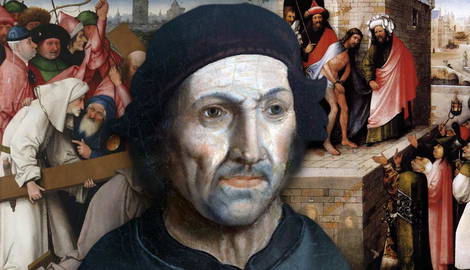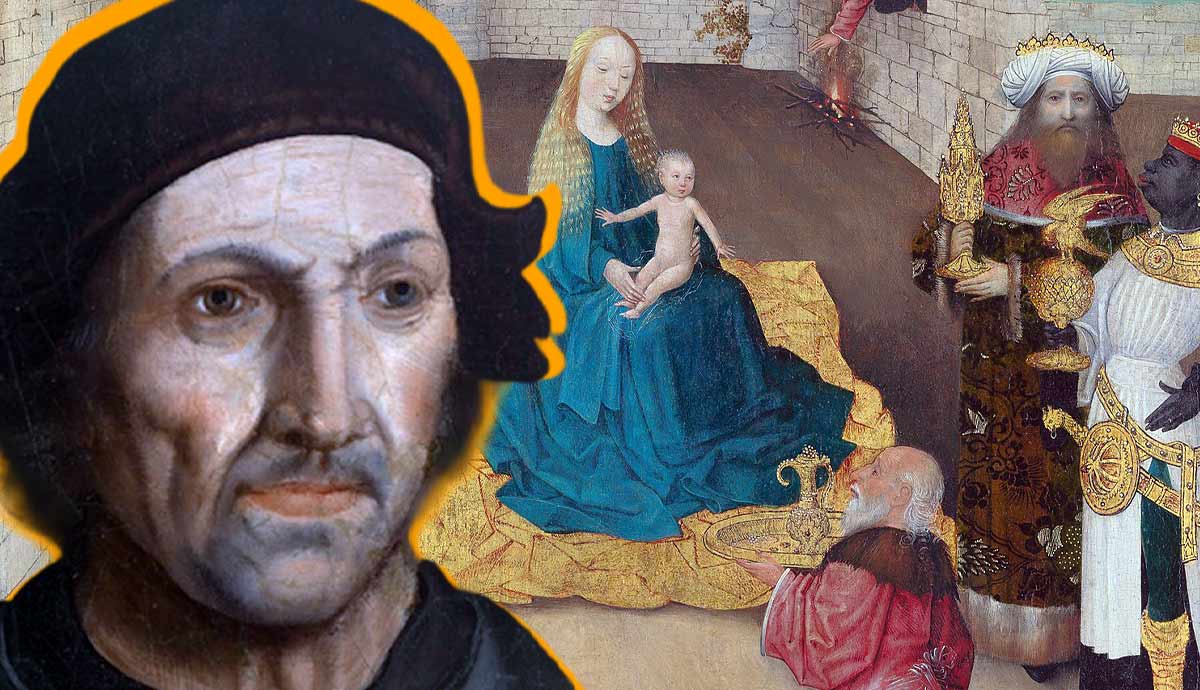
Hieronymus Bosch’s mysterious personality and artistic mind have fascinated both art historians and the public for centuries. There are almost no documentary sources left about the famous artist. For that reason, researchers have to rely on the evidence of Bosch’s surroundings and the fascinating symbols occurring in his paintings. Read on to learn more about the visionary mind of Hieronymus Bosch.
Hieronymus Bosch: Are There Any Famous Quotes Attributed to Him?

Hieronymus Bosch is one of the most famous artists of the Late Middle Ages and Early Renaissance. Despite that, he is one of the most mysterious figures, as he left almost no written documentary sources about himself. In the Medieval paradigm of thinking, the issue of the painter’s authorship and identity was not treated as important. Although many artists left behind countless aphorisms and anecdotes, Bosch’s active voice remained only in his paintings. We know for sure that during his lifetime, he was a well-known and popular artist who amazed his contemporaries with his complex work.
After Bosch died in 1516, his fame gradually wavered. One of the reasons for that was the fact that his most exquisite and complex works, like The Garden of Earthly Delights, ended up in Spanish collections and became hardly available for art lovers in his native country. The great revival of Hieronymus Bosch’s art happened in the late 19th century. For more than a hundred years, Bosch has remained relevant and exciting for both the masses and art experts due to his expressive style and compositional choices.
Given the limited scope of documentary sources concerning Bosch’s life and work, the most important evidence that allows us to speculate on his personality and ideas is his artistic works. However, the surviving oeuvre of Bosch consists of less than two dozen works. The exact number is the subject of constant debate and conflict among art historians. The most recent catalogue raisonné, published in 2016, the 500th anniversary of the artist’s death, contained only 21 paintings.

In the 20th century, when Bosch’s works once again became immensely popular, more and more newly attributed works surfaced on the art market. Yet almost none of them were added to the generally accepted list. Most of the works mistakenly attributed to the artist were painted by imitators in the 16th century after the artist’s death. It is possible that some of the works were made by his students or studio assistants, but the information about Bosch’s atelier is absent from surviving sources.
The most upsetting part of the Bosch oeuvre research is that we barely have any idea about the quality and characteristics of his surviving works in relation to everything he created. We cannot certainly trace the recurring symbols or the transformation of his artistic style. Moreover, it is quite possible that the works by Bosch considered his best by his contemporaries did not survive. Another issue is caused by the fact that Bosch never dated any of his works, thus making it next to impossible to build a coherent timeline of his career.

However, the surviving works allow us to make certain assumptions about general trends in Bosch’s work. According to the tradition of his era, Bosch was primarily a religious painter who created work following the pre-Reformation Christian doctrine. During his entire life, Bosch frequently created devotional work for the Brotherhood of Our Lady, a religious community formed by the most respectful residents of Bosch’s native city of s-Hertogenbosch.
The earliest known work by Hieronymus Bosch is a painting titled Adoration of the Magi, created in the early 1470s. The painting already had some of Bosch’s significant technical features (such as the application of paint or the way of preparing the board for painting), yet still mostly imitated the then-fashionable style and composition. Most likely, Bosch was studying the works of his contemporaries (possibly, family members), who painted similar scenes. Still, the artist used unusually vivid colors and paid a special amount to small details of landscapes and dresses.
Bosch’s Angry Mob

Another significant painting of Hieronymus Bosch’s early period is Ecce Homo, depicting the Biblical scene of parading Jesus in front of an angry mob before his crucifixion. Attributed to 1475-85, it already demonstrated one of the principal themes in Bosch’s art, the angry foolishness of the crowd that inevitably leads every single one of its members to damnation and eternal suffering. Each figure within the crowd mocking Jesus represents a different caricature of humanity’s worst qualities. His later works, including The Last Judgement and The Garden of Earthly Delights, also feature this idea of humans being unable to comprehend the depths of their corruption and unreason.

Among the few surviving painted works by Bosch, three relate to the scene of Jesus carrying the cross to the place of his execution, surrounded by the mob that enjoyed his suffering. There, Bosch expanded his way of depicting uncontrollable and corrupt crowds and gave more horrid variety to it. His paintings of the crucifixion featured an inventive variety of odd and repulsive faces, but there were also those who acted as an alternative to it. The painting, loosely dated to the 1498-1507 period, included a character briefly mentioned in the Bible but rarely included in artworks. The man in white clothes on the left part of the panel is Simon of Cyrene.
Most likely, he did not know Jesus before his execution but nonetheless helped him carry the cross. In Bosch’s painting, Simon’s act of compassion (debated in some interpretations of the Bible) was likely meant to serve as an alternative to the mocking and laughing crowd and the only acceptable behavior for a decent person, not necessarily a Christian. Despite no apparent relation to Jesus, Simon chose to share his pain. As a devout Christian, Bosch painted this scene, gruesome and tragic, in overall joyful light, focusing primarily on Simon’s compassionate impulse.
Bosch’s Monsters

Hieronymus Bosch’s oeuvre is particularly famous for the strange and unsettling creatures that inhabit his most famous works. For the first time in his surviving works, a monster appears on a two-sided panel John the Evangelist on Patmos, where a strange creature, half-lizard and half-man wearing a cloak and glasses, tries to steal the Evangelist’s inkwell.
Bosch’s creatures are mostly unambiguous and represent the evil forces sent to disturb the faithful and corrupt their deeds. What is clear from his paintings is the enjoyment he felt from designing and painting his monstrous creatures. They were diverse, original, and painted with minuscule detail related to human vices and malicious qualities. Their strange forms were derived from all creatures known to Bosch, mixing traits of humans, animals, birds, and insects.
Most frequently, such nightmarish hybrids appear in the scenes related to the Last Judgement and Hell and are often surrounded by walls of flames, throwing red light onto the dark scenes of torment and pain. Most historians agree that such a vision was provoked by Bosch’s own traumatic experience. In 1463, a fire destroyed 4,000 houses in ‘s-Hertogenbosch, including Bosch’s family home. The artist was then still a pre-teen and, most likely, was deeply traumatized by the sight of city life collapsing in flames.
Hieronymus Bosch’s Occult Associations

In 1947 art historian Wilhelm Fraenger proposed a theory according to which Bosch’s strange and unusual imagery might have been the result of his association with an obscure Adamite cult. The Adamites originated in the early days of Christianity around the 2nd century CE. The Adamites believed in the need to re-establish the primal innocence of Adam and Eve. They performed their religious services nude and rejected the religious concept of marriage. Fraenger explained the prevalence of nude figures in Bosch’s paintings—particularly in the scene from The Garden of Earthly Delights—as a reflection of the artist’s association with the cult. However, most historians reject this idea, basing their arguments on Bosch’s prominent position in the mainstream Christian community that did not tolerate heresy.
Another questionable theory was that Bosch, consciously or not, used hallucinogenic substances like ergot, a type of fungi developing on rye bread. Allegedly, hallucinations provoked by these substances could have inspired Bosch’s odd figures and monstrous creatures. However, most art historians disagree with this idea, believing that the artist’s creativity did not need to be fueled by different substances. Moreover, the state of concentration required to paint such an immense amount of detail present in Bosch’s paintings does not fit well with the effects of these drugs.










